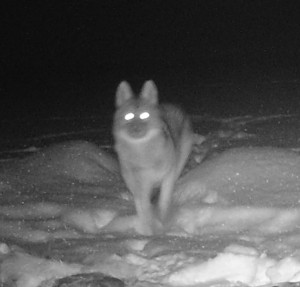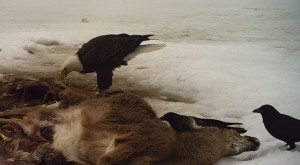Warmer temperatures could be detrimental to animal, fish species

Coyote

Eagle and a crow
Some spring weather has finally come to the Adirondacks, but it sounds like it will be an up and down week with a little rain, a little snow and some warmer temperatures.
The claim is that we have seen the warmest temperatures in four thousand years—now that’s a big change.
I know last summer was the warmest that I can remember up this way. Many small ponds got so warm that there was no cold zone for the fish to live in. These ponds were warm from the top to the bottom.
That’s not a good thing for brooktrout that might have been there.
This is also a limiting factor for animals such as Moose which need cooler temperatures to even survive. We are right on the edge of their range and warmer temperatures may push them over the edge. A five degree difference in their body temperature can kill them.
I’ve got a snowshoe hare that’s been checking out the shrubs around the house for the past couple weeks.
Luckily I have most of them enclosed in wire to protect them from the deer so they had no place to nibble.
There are a few tops out back that were brought down by the wet snow and this hare has completely stripped them of bark. I haven’t caught the hare on camera yet but I may this week.
This morning I could just see his nail marks in the crust but no foot prints. Those big feet hold them up even on the lightest crust.
Doug Riedman came over with his little hound Brook and chased hares out back for a few hours last Tuesday. It took a while to get them going but once Brook got them started the woods were full of noise.
She is a little speed demon and since I only take a 22 in the woods I didn’t stand a chance of hitting the white streaks that went by.
We did get two hares that day but it took a few shots from a shotgun to do it.
I don’t know where my big flock of hen turkeys went as they haven’t been around in about a month. Six toms are still coming for a snack each day.
All but one of them has lost their beards as they got pulled out in the wet snow.
The one with a beard must have been the last in line as they pushed through the deep snow. You would have a tough time finding a beard on these birds during the spring season.
Another Bald Eagle has been visiting the pond. It’s a younger bird as it does not have a full white head and tail.
A coyote has been taking away the carcasses I put out for the eagles so I have been going up in the woods to drag them back. I have them wired down tonight so they may have a tougher time taking them away.
With these warmer temperatures I was sure someone would have Red-winged Blackbirds. This morning I got a report from MaryAnn Nelson in Thendara who said she had six of them at her feeder.
A couple robins were heard singing in the Forestport area and a couple geese were flying north over Boonville.
The chickadees are giving their phoebe calls and the white-breasted nuthatches are giving their wood-wood calls.
The calls are used by birds this time of year to claim their territory—sure signs that spring is happening.
My friend over in Burlington, VT has several white-throated sparrows at his feeder already so we may miss them again at Crown Point when we’re banding there in May.
I will be leading a bird banding program at View on Sunday, March 17, St. Patrick’s Day. The program is part of View’s Science on Sundays programming and begins at 2 p.m.
The presentation will be followed by a closing reception for an exhibit featuring my son Mitch’s paintings, my photographs, and Constance Smith’s wildlife paintings on turkey feathers.
Putting a few beavers on the boards, but that’s another story. See ya.
